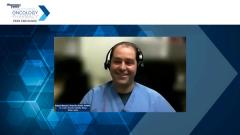
Novel Agents for Relapsed/Refractory Myeloma
Best practices for prescribing an immunomodulatory-based therapy or a proteasome inhibitor as treatment for relapsed/refractory multiple myeloma.
Episodes in this series

Bhavesh Shah, RPh, BCOP: One thing that I wanted to touch on was the IMiD [immunomodulatory imide drug] vs the PI [proteosome inhibitor] combination. I can’t imagine a center that’s not using VRd [bortezomib, lenalidomide, dexamethasone] or CRd [cyclophosphamide, bortezomib, dexamethasone] up front. What happens afterward? What are you doing in your practice?
Heather Pound, PharmD, BCPS, BCOP: When the POLLUX trial came out, you saw the response rates were 85%, 90%. It was 1 of those things where you’re saying, “This can’t be true in myeloma.” You don’t see overall response rates of 80%, 90% in a relapsed/refractory setting. Obviously it’s true and it’s held the test of time. As you’re trying to sequence those things, do you go toward the OPTIMISMM trial, where you’ve got pom-Velcade-Dex [pomalidomide-bortezomib-dexamethasone]?
You have this mix of oral and IV [intravenous] therapy, and you split the cost difference between the 2. Do you go to an almost all-oral regimen, like the STOMP data, when you have selinexor with pomalidomide and dexamethasone? For patients at home, especially in the times of COVID-19, they can pop into the lab. Some insurance companies are even having labs go out to the patient. That’s even less of a risk. Some of those things are interesting players in the field.
Bhavesh Shah, RPh, BCOP: Thank you, Heather. Anything else, Doug? We have some updates that came out of ASH [American Society of Hematology Annual Meeting]. Do you want to highlight anything from ASH before we move on to the next segment?
Douglas Braun, CSP, PharmD, RPh: There were a couple of updates at ASH looking at the CANDOR trial updates. CANDOR was the 1 that added plus or minus daratumumab to the carfilzomib-dexamethasone group. Multiple myeloma relapsed after 1 or 3 lines of therapy. After 16.9 months, median PFS [progression-free survival] hasn’t been reached. With 11 months of additional follow-up, we’re seeing 13.4-month improvement in median PFS with those patients who got daratumumab. There is a favorable benefit-risk profile showing a really good efficacious treatment options for the patients with relapsed/refractory multiple myeloma. There are definitely data supporting the use, so I’m excited about that.
The other trial was IKEMA. The IKEMA trial was the addition of the isatuximab—as we spoke before—to the carfilzomib group. We also saw a significant improvement in PFS and nearly half the risk of disease progression or death vs Kd [carfilzomib, dexamethasone] alone in that analysis. There is a clinically meaningful improvement of depth of response with the isatuximab group, which is showing really good results even with the potential adjusted CR [complete response] rate. Going back to MRD [minimal residual disease], we’ve got some MRD negativity there—twice as many in this group. We don’t always know what MRD negativity means, but we know that it is associated with longer PFS. We’re hoping for exciting data there. We’ll see how it works out moving down with further lines of therapy.
Bhavesh Shah, RPh, BCOP: That’s definitely a controversial area. Hopefully we’ll find some more answers as we incorporate more into clinical trials and have long-term data. Thank you for sharing that.
Transcript edited for clarity.
Newsletter
Stay informed on drug updates, treatment guidelines, and pharmacy practice trends—subscribe to Pharmacy Times for weekly clinical insights.
















































































































































































































